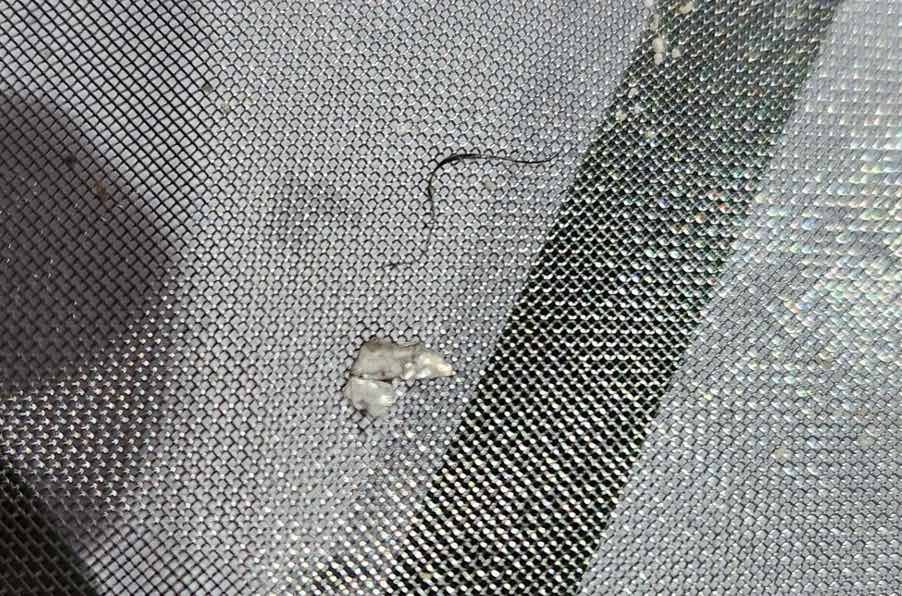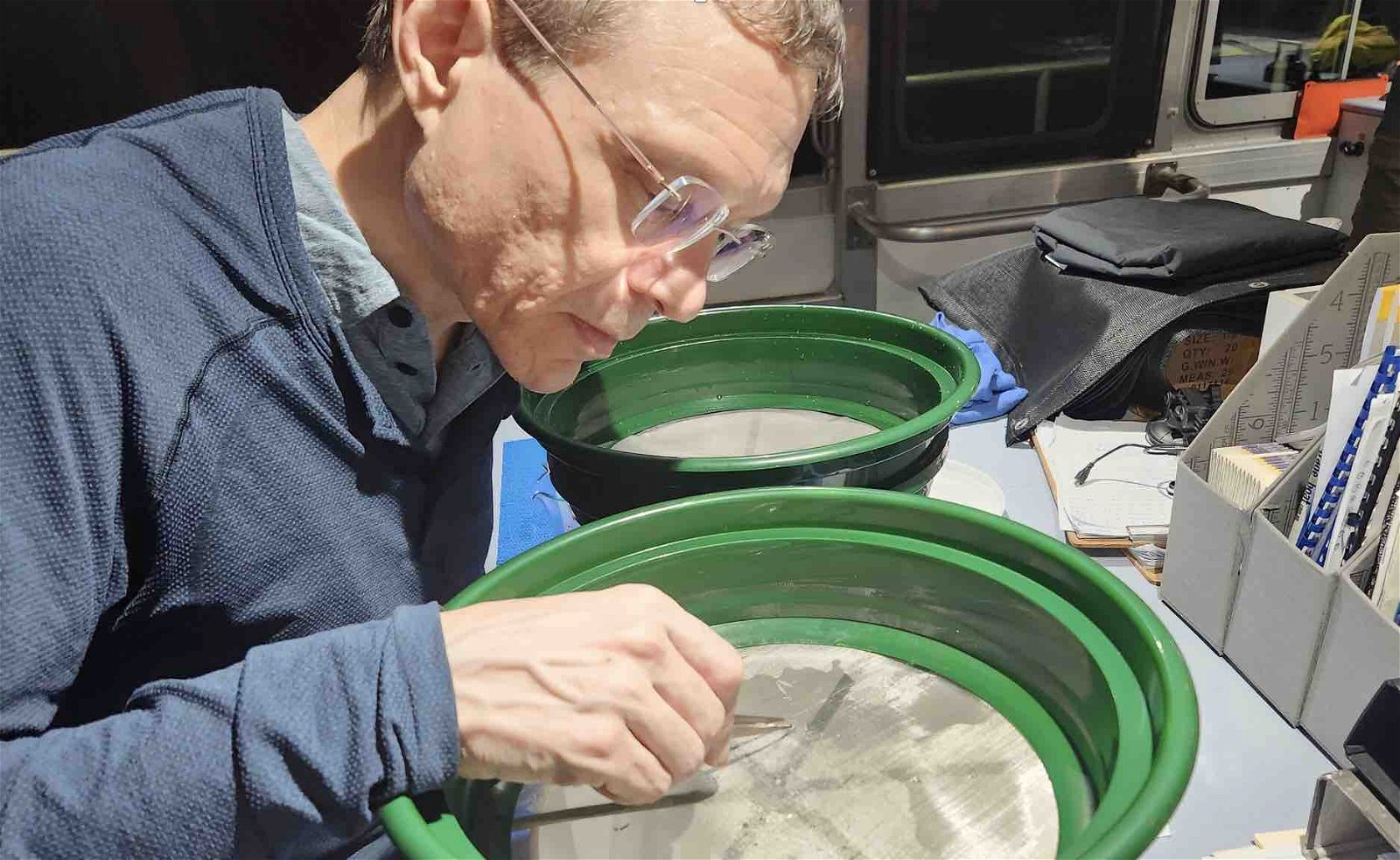These combined seventh and eighth installments in an ongoing series of updates from Harvard Astronomer Avi Loeb, head of The Galileo Project, document the team’s expedition to attempt the recovery of an interstellar object from the floor of the Pacific Ocean. This combined two-part entry covers Day 6 (June 16, 2023) and Day 7 (June 17, 2023) of the team’s expedition.
Part 7 (June 16, 2023)
Shortly after my morning jog at sunrise, a member of the Silver Star’s crew came with excitement and gave me a fragment that he found at the periphery of one of the magnets on the far-right corner of the sled. It looked like a curled shard that was scraped off a metallic surface. I was thrilled and held the shard with my finger as I climbed up the stairs to present it to our geologist, Jeff Wynn. Jeff immediately concluded that the fragment is non-magnetic.
Afterward, Ryan Weed analyzed the composition of this shard and concluded that it is most likely human-made. He noted: “The ocean is full of trash, from plastics and metallic pieces to biological debris and products of geological processes. We are yet to find something truly extraterrestrial.”


We must keep in mind that all the fragments were collected from the ocean floor, which accumulated debris over many decades of human history. The search area was an active war zone between Japan and the United States in World War II. Ryan pointed out that it is possible to distinguish fragments that were created before and after the War by identifying radioactive isotopes that contaminated the entire Earth after atomic bombs exploded over Hiroshima and Nagasaki in August 1945. We need a few grams of debris to get a good assessment of radioactive isotopes from our gamma-ray detector, but so far, our sample is too small, about a tenth of a gram.


Our X-ray fluorescence analyzer indicates that some of our fragments are made of aluminum. There are two local sources rich in aluminum: the sled (made of aluminum 6061 to avoid magnetic effects) and the ship Silver Star. We will be sure to ignore any fragment with an identical composition to these objects.


Most particles are tiny, consistent with volcanic ashes as found in the latest control region. The only exception came in the form of a few thin wires and oddly shaped fragments.
While watching the sled being pulled out of the water at midnight, I did a quick calculation in my head. The mass ablated from IM1 during the fireball can be estimated from the explosion energy and the measured speed of IM1. This data implies a total ablated mass of about 500 kilograms.
If all 500 kilograms of IM1 fragmented into millimeter-sized particles, there would be a maximum number of about a hundred million fragments. It is reasonable to assume that the meteor fragments were scattered across an area of several tens of square kilometers. The sled has a width of a meter as it crosses that area, implying that it would sweep across at most tens of thousands of millimeter-sized fragments in one run. This adds up to an upper limit of hundreds of grams in millimeter-sized fragments. The magnetic sled is reaching a sensitivity of one part in a thousand of this maximum value as it alerts us to merely a tenth of a gram per run. Clearly, much of IM1’s mass could have been vaporized into dust particles smaller than a millimeter. Such an outcome would be difficult to separate from the abundant background of tiny particles associated with terrestrial volcanic ashes.
Today, Silver Star is surveying thoroughly a second 10-kilometer line near the most likely path of the first recognized interstellar meteor, IM1. Initially, the ocean current at the ocean floor was different from that on the surface and the winch line went sideways, but a few hours later the ocean currents disappeared, allowing the ship to follow IM1’s direction of motion. The navigation leader, Art Wright, just updated me that we will survey thoroughly a line through the center of IM1’s localization box offered by the US Department of Defense. This task will take up most of the day, and we hope to get a good sample of much more material this evening.
Finding interstellar materials is a tall order. But the consequences of finding them are large. The immediate consequences include the opening of a champagne bottle in the refrigerator of Silver Star, as well as featuring an update in the Galileo Project video on display at Times Square.
Part 8 (June 16, 2023)


After our first run through the site of the first recognized interstellar meteor, IM1, we found plenty of volcanic dust on our magnetic sled, containing tiny particles less than a tenth of a millimeter in size. I was able to remove them from the sled magnets with a painter’s brush. We had only one suitable brush, contributed by Jeff Wynn’s wife, who is an artist. Rob McCallum ordered many more to be picked up in our next land visit. We did not anticipate this need, which illustrates the art of doing science.
We thought that the harvest of IM1’s site yields the same materials as the control regions away from that site until we noticed a strange curled wire, which we now label IS1-2 (an abbreviation for the second unusual fragment from the first IM1 Run) on top of one of the magnets. The fundamental question is why was it not washed away by the ocean water as the sled was dragged by the ship Silver Star. The most plausible explanation is that the volcanic, magnetic particles held it in place like a magnet holding a piece of paper in place on a magnetic pad. The wire is 8-millimeter long and curved twice with a rigid structure. What is it made of?
Today, Ryan Weed and Jeff Wynn analyzed in detail this unexpected wire and concluded that its composition is anomalous compared to human-made alloys. For the composition analysis, Ryan used the X-ray fluorescence analyzer manufactured by Bruker – whose CEO, Frank Laukien, co-founded with me the Galileo Project. Ryan concluded that IS1-2 has two composition peaks at manganese and platinum, abbreviated as Mn and Pt in the periodic table.
American Elements lists MnPt alloys with a molecular weight of 250.02 in many forms including wires. Jeff noted that MnPt is mostly platinum and used for non-corroding electrodes in laboratories. However, IS1-2 is very different in the relative composition of Mn and Pt from these electrodes.
The American Elements website says: “Manganese Platinum Alloy is available as disc, granules, ingot, pellets, powder, rod, wire, foil, and sputtering target. Ultra-high purity and high-purity forms also include metal powder, submicron powder and nanoscale, quantum dots, targets for thin film deposition, pellets for evaporation, and single crystal or polycrystalline forms. Elements can also be introduced into alloys or other systems as compounds such as fluorides, oxides, or chlorides or as solutions.”
Ryan’s analysis revealed the following composition for IS1-2 (in arbitrary units of abundance by number):
- MnO: 2.109 (Mn: 0.6355)
- Al2O3: 0.0836
- SiO2: negligible
- Pt: 0.0014
- Ni: 0.0222
- Sn: 0.0236
- Ce: 0.0563
This constitutes the first anomaly found at the IM1 crash site. I was worried about possible contamination from the ship deck. A member of the expedition crew swiped the floor of the Silver Star’s deck with magnets and brought the results to me. There was nothing there that looked like IS1-2.
We are expecting to get our second sample tonight. I plan to stay awake until my morning jog at sunrise. By then, I hope to know whether the first recognized interstellar object from our cosmic neighborhood, IM1, carried materials that are anomalous relative to what we find in our backyard around the Sun. And most importantly, I wish to know whether it was manufactured technologically by another civilization.
At dawn, I will report back about any interesting result from our second run at IM1’s site from January 8, 2014.
The navigation leader, Art Wright, just updated me about the timing of the sled pullout from the ocean floor. He concluded by adding: “We hope to bring you more good stuff to analyze.” Art graciously chose to join us for the expedition because he was so excited about its scientific mission. As Oscar Wilde noted, “We are all in the gutter, but some of us are looking at the stars.”
Avi Loeb is the head of the Galileo Project, founding director of Harvard University’s – Black Hole Initiative, director of the Institute for Theory and Computation at the Harvard-Smithsonian Center for Astrophysics, and the former chair of the astronomy department at Harvard University (2011-2020). He chairs the advisory board for the Breakthrough Starshot project, and is a former member of the President’s Council of Advisors onScience and Technology and a former chair of the Board on Physics and Astronomy of the National Academies. He is the bestselling author of “Extraterrestrial: The First Sign of Intelligent Life Beyond Earth” and a co-author of the textbook “Life in the Cosmos”, both published in 2021. His new book, titled “Interstellar”, is scheduled for publication in August 2023.

